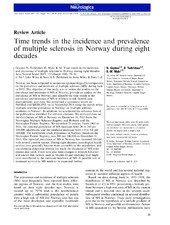| dc.description.abstract | Norway has been subjected to numerous epidemiological investigations on the prevalence and incidence of multiple sclerosis (MS), dating back to 1935. The objective of this study was to review the studies on the prevalence and incidence of MS in Norway, provide an update on the prevalence of MS in Norway, and describe the time trends in the prevalence and incidence of MS in relation to risk factors, case ascertainment, and data. We performed a systematic search on PubMed and MEDLINE up to November 2014 using the search string ‘multiple sclerosis prevalence in Norway’ or ‘multiple sclerosis incidence in Norway’. In addition, we scrutinized the reference lists of the publications identified for relevant citations. We retrieved data on the distribution of MS in Norway on December 31, 2013 from the Norwegian Multiple Sclerosis Registry and Biobank and the Norwegian Patient Registry. We identified 29 articles. From 1961 to 2014, the reported prevalence of MS increased from 20 to 203 per 100,000 inhabitants, and the incidence increased from 1.9 to 8.0 per 100,000. The nationwide crude prevalence in Norway, based on the Norwegian Patient Registry, was 208 per 100,000 on December 31, 2013. The reported prevalence of MS in Norway has increased 10-fold, with several possible causes. During eight decades, neurological health services have generally become more accessible to the population, and transforming diagnostic criteria has made the diagnosis of MS more precise and valid. There have also been changes in lifestyle behavior and known risk factors, such as vitamin D and smoking, that might have contributed to the increased incidence of MS. A possible role of increased survival in MS needs to be examined further. | en_US |

